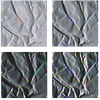Free Online Productivity Tools
i2Speak
i2Symbol
i2OCR
iTex2Img
iWeb2Print
iWeb2Shot
i2Type
iPdf2Split
iPdf2Merge
i2Bopomofo
i2Arabic
i2Style
i2Image
i2PDF
iLatex2Rtf
Sci2ools
CVPR
2004
IEEE
2004
IEEE
Hybrid Textons: Modeling Surfaces with Reflectance and Geometry
The appearance of surface texture as it varies with angular changes of view and illumination is becoming an increasingly important research topic. The bidirectional texture function (BTF) is used in surface modeling because it describes observed image texture as a function of imaging parameters. The BTF has no geometric information, as it is based solely on observed texture appearance. Computational tasks such as recognizing or rendering typically require projecting a sampled BTF to a lower dimensional subspace or clustering to extract representative textons. However, there is a serious drawback to this approach. Specifically, cast shadowing and occlusions are not fully captured. When recovering the full BTF from a sampled BTF with interpolation, the following two characteristics are difficult or impossible to reproduce: (1) the position and contrast of the shadow border, (2) the movement of the shadow border when the imaging parameters are changed continuously. For a textured surface...
Bidirectional Texture Function | Computer Vision | CVPR 2004 | Observed Image Texture | Observed Texture Appearance | Surface Texture | Texture Prediction |
| Added | 12 Oct 2009 |
| Updated | 29 Oct 2009 |
| Type | Conference |
| Year | 2004 |
| Where | CVPR |
| Authors | Jing Wang 0008, Kristin J. Dana |
Comments (0)

